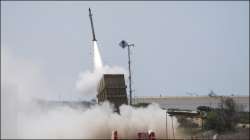Project Kusha: Will it become India's own version of Iron Dome defence system? EXPLAINED
The ambitious indigenous project will be developed by the Defence Research and Development Organisation (DRDO) at an estimated budget of Rs 21,700 crore. Like Israel's Iron Dome system, it will provide the Indian Air Force to detect and destroy hostile targets from a large range.

Amid the Israel-Hamas war, the Iron Dome air defence system has garnered much attention for its state-of-the-art defence capability and interception of rockets from a large distance. Now, a similar, if not better, project will be undertaken by India to build its first air defence system that is said to be deployed by 2028-29.
According to reports, India's own long-range air defence system, titled 'Project Kusha', is being developed by the Defence Research and Development Organisation (DRDO). It will be capable of detecting and destroying enemy projectiles and armour, including cruise missiles, stealth fighter jets, and drones at long range.
The ambitious project is believed to not only perform better than Israel's Iron Dome system, but also rival the effectiveness of Russia's S-400 system and the 'Patriot' system of the United States. It will represent a significant milestone in India's pursuit of Aatmanirbhar Bharat.
How will it work?
The indigenous long-range surface-to-air defence system (LR-SAM) includes long-range surveillance and fire control radars, along with interceptor missiles that can detect and strike hostile targets at the ranges of 150 km, 200 km, and 350 km. It will also be effective in providing strategic and tactical cover.
The system reportedly has a single-shot kill chance of at least 80% and over 90% when two missiles are fired after each other. The surveillance and fire control radars will enable the Indian Air Force (IAF) to effectively monitor the airspace and defend against enemy strikes.
Additionally, the firing units of the LR-SAM system will also be able to interact with the IAF's air command and control system to integrate a wide array of military radars. Overall, this desi version of the Iron Dome system will significantly boost India's defence capability and ensure the safety of Indian airspace by detecting and targeting hostile forces from a very long distance.
How much does it cost?
It is worth mentioning that India already possesses Russia's S-400 air defence system. It has signed a contract with Russia for five squadrons of the S-400 air defence missile systems, out of which three units have been delivered on time while the remaining two have not been supplied yet due to complications following the Ukraine war.
'Project Kusha' received approval for funding amounting to an estimated budget of Rs 21,700 crore for five squadrons. The DRDO will spearhead the initiative with the involvement of both the public and private sectors.
If developed successfully, the ambitious project will launch India into an elite group of countries that possess indigenous capabilities to tackle aerial attacks over long distances.
Why do we need it?
The need for such a project is quite high in current times with threats emerging from neighbourhood countries like Pakistan and China. The latter also uses Russia's S-400 missile system and has deployed several missile batteries across the Line of Actual Control (LAC).
China has also accelerated the production of indigenous defence capabilities to strengthen its military. Although they are considered less capable than the S-400, nevertheless they represent a serious threat to India. Considering that China can fire missiles at India, it is pertinent that New Delhi arm itself with state-of-the-art air defence systems.
India's relations with China have nosedived following the Galwan Valley dispute in 2020, marking the most serious military conflict between both sides. India and China's strained relationship has been fueled by recent Chinese provocations, including releasing the 2023 edition of its “standard map”, staking a claim over Arunachal Pradesh, Aksai Chin region and denial of visas to Indian athletes in the Hangzhou Asian Games.
Another thing to be taken into consideration is that China is an 'all-weather friend' to Pakistan, and might help Islamabad to strengthen the latter's defence capabilities to be used against India. Faced with the challenges, 'Project Kusha' is another effort by India in deterrence against a two-front conflict.
About Israel's Iron Dome system
Project Kusha is said to be comparable, if not better, than Israel's Iron Dome system. The Iron Dome is a ground-to-air defence system that comprises radar and interceptor missiles that are capable of tracking and neutralising any rockets or missiles fired towards targets in Israel.
It is particularly useful in defending against rockets, artillery and mortars, as well as aircraft, helicopters and unmanned aerial vehicles (UAVs). The Dome has a range of close to 70 km and has three crucial components, Detection and Tracking radar, Battle Management and Weapons Control and the Missile Launcher armed with 20 Tamir Missiles.
The air defence system was long touted to be the best in business and providing ironclad security to Israel. However, it found itself overpowered when Hamas launched a barrage of rockets from the Gaza Strip, as Israel's robust intelligence security agencies were caught completely off-guard.
ALSO READ | Israel-Palestine conflict: Why do terror groups like Hamas take people hostage? Explained